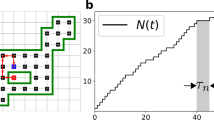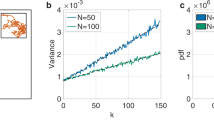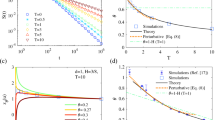Abstract
THE number of distinct sites visited by a random walker after t steps is of great interest1–21, as it provides a direct measure of the territory covered by a diffusing particle. Thus, this quantity appears in the description of many phenomena of interest in ecology13–16, metallurgy5–7, chemistry17,18 and physics19–22. Previous analyses have been limited to the number of distinct sites visited by a single random walker19–22, but the (nontrivial) generalization to the number of distinct sites visited by TV walkers is particularly relevant to a range of problems-for example, the classic problem in mathematical ecology of defining the territory covered by N members of a given species13–16. Here we present an analytical solution to the problem of calculating SN(t), the mean number of distinct sites visited by N random walkers on a d-dimensional lattice, for d = 1, 2, 3 in the limit of large N. We confirm the analytical arguments by Monte Carlo and exact enumeration methods. We find that there are three distinct time regimes, and we determine SN(t) in each regime. Moreover, we also find a remarkable transition, for dimensions ≳2, in the geometry of the set of visited sites. This set initially grows as a disk with a relatively smooth surface until it reaches a certain size, after which the surface becomes increasingly rough.
This is a preview of subscription content, access via your institution
Access options
Subscribe to this journal
Receive 51 print issues and online access
$199.00 per year
only $3.90 per issue
Buy this article
- Purchase on Springer Link
- Instant access to full article PDF
Prices may be subject to local taxes which are calculated during checkout
Similar content being viewed by others
References
Montroll, E. W. & West, B. J. in Fluctuation Phenomena (eds Montroll, E. W. & Lebowitz, J. L.) (North-Holland Personal Library, 1987).
Montroll, E. W. & Shlesinger, M. F. in Nonequilibrium Phenomena II. From Stochastics to Hydrodynamics (eds Lebowitz, J. L. & Montroll, E. W.) 1–121 (North-Holland, Amsterdam, 1984).
Dvoretzky, A. & Erdös, P. in Proc. 2nd Berkeley Symp. 33 (University of California, Berkeley, 1951).
Vineyard, G. H. J. math. Phys. 4, 1191–1193 (1963).
Beeler, R. J. & Delaney, J. A. Phys. Rev. A130, 962–966 (1963).
Beeler, R. J. Phys. Rev. A134, 1396–1401 (1964).
Rosenstock, H. B. Phys. Rev. A187, 1166–1168 (1969).
Montroll, E. W. in Stochastic Processes in Applied Mathematics XVI, 193–220 (American Mathematical Society, Providence, 1964).
Montroll, E. W. & Weiss, G. H. J. math. Phys. 6, 167–177 (1965).
Jain, N. C. & Orey, S. Israel J. Math. 6, 373–380 (1968).
Henyey, F. S. & Seshadri, V. J. chem. Phys. 76, 5530–5534 (1982).
Torney, D. C. J. stat. Phys. 44, 49–66 (1986).
Skellam, J. G. Biometrika 38, 196–218 (1951).
Skellam, J. G. Biometrika 39, 346–362 (1952).
Pielou, E. C. An Introduction to Mathematical Ecology (Wiley-lnterscience, New York, 1969).
Edelstein-Keshet, L. Mathematical Models in Biology (Random House, New York, 1988).
Smoluchowski, M. v. Z. phys. Chem. 29, 129 (1917).
Rice, S. A. Diffusion-Controlled Reactions (Elsevier, Amsterdam, 1985).
Haus, J. W. & Kehr, K. W. Physics Rep. 150, 263–416 (1987).
Havlin, S. & Ben-Avraham, D. Adv. Phys. 36, 695–798 (1987).
Bouchaud, J.-P. & Georges, A. Physics Rep. 195, 127–293 (1990).
Bunde, A. & Havlin, S. (eds) Fractals and Disordered Systems (Springer, Berlin, 1991).
Barber, M. N. & Ninham, B. W. Random and Restricted Walks (Gordon & Breach, New York, 1970).
Berg, H. C. Random Walks in Biology (Princeton University Press, 1983).
Weiss, G. H. & Rubin, R. J. Adv. chem. Phys. 52, 363–475 (1983).
Author information
Authors and Affiliations
Rights and permissions
About this article
Cite this article
Larralde, H., Trunfio, P., Havlin, S. et al. Territory covered by N diffusing particles. Nature 355, 423–426 (1992). https://doi.org/10.1038/355423a0
Received:
Accepted:
Issue Date:
DOI: https://doi.org/10.1038/355423a0
This article is cited by
-
Universal exploration dynamics of random walks
Nature Communications (2023)
-
A random-walk-based epidemiological model
Scientific Reports (2021)
-
The explanatory dispensability of idealizations
Synthese (2016)
-
Coverage maximization under resource constraints using proliferating random walks
Pramana (2015)
-
Modelling the scaling properties of human mobility
Nature Physics (2010)
Comments
By submitting a comment you agree to abide by our Terms and Community Guidelines. If you find something abusive or that does not comply with our terms or guidelines please flag it as inappropriate.



